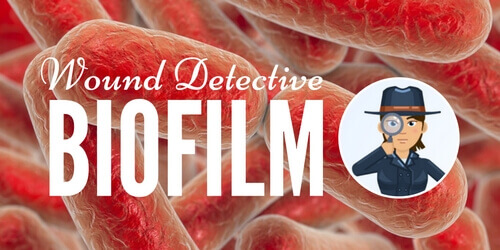Even the best wound care detectives are challenged by this sneaky culprit that delays healing. Here’s how to identify biofilm bacteria and solve the case.
Ready for some serious detective work? In this wound-care case, we will try to find and invade the elusive biofilm bacterial hide-out. So the questions are: where are those microbes holed up, how do I know if they are even there, and how do I get rid of them?
Put on your Wound Detective hat – this one’s going to be tough. Even with your trusty magnifying glass, it’s not easy to spot the signs and symptoms of biofilm in your patients’ wounds.
The Mystery
This is the classic case of bacteria banding together (polymicrobial) into communities which make up biofilm. To protect themselves, the bacteria cover their turf with a slimy barrier of proteins and sugars (Polysaccharide matrix). This barrier dome serves as protection from the patient’s own internal immune system and external factors, such as antibiotics and antiseptics used to treat the wound bed.
To make matters worse, this stealth protective barrier usually can’t be seen, showing little or no signs or symptoms of infection in the wound bed. Clinicians may not be able to rely on clinical signs and symptoms to determine if biofilm Is present.
Of course this is incredibly frustrating, because when chronic wounds just won’t heal, the first thing we do is to look for clues and find out the reasons why. And while there are a multitude of possible reasons, a clever wound detective will consider biofilm as a suspect.
Let’s start with the facts: biofilm is present in 60% of chronic wounds, and has the potential to delay healing, so you’re going to need to know what to look for.
The Clues
Are you ready to sniff out the clues that biofilm gives us in order to identify its presence in the wound bed? Here are the usual suspects at the wound site:
- Non-healing chronic wound for 2-4 weeks, in spite of advanced wound care
- Antibiotic failure
- Infection of greater than 30 days’ duration
- Friable granulation tissue
- Necrotic tissue in wound
- Chronic inflammation in the wound bed from toxins secreted by microbes
- High moisture in wound bed
- A gelatinous material easily removed from wound surface that readily comes back
- Regarding culturing the wound – due to the barrier dome the organisms within the biofilm cannot be detected using normal wound culture method, a Levine culture or microscopy is indicated
Here are typical clues hidden within the patient’s condition:
- May not show signs and symptoms of colonization or infection
- Diminished immune system – low white blood cell count, chemotherapy, disease processes such as diabetes, cancer, auto-immune issues, hyperglycemia
- Malnutrition
Solve the Case
Once you suspect biofilm as the culprit, here’s how to nab it:
- Cleanse the wound at each dressing change (there is evidence that the use of surfactant based cleansers and dressings help remove biofilms)
- Therapeutic irrigation – 4-15 PSI has been found to be effective in removing debris and helping to break up the biofilm colony
- When wound infection is suspected, cleanse with an antiseptic solution such as PHMB, silver and povidone iodine
- Frequent sharp debridement followed by antimicrobial dressings – silver, cadexomer iodine, hydrofera blue, medical grade honey
- Larval debridement reduces necrotic tissue and bacteria
- Manage moisture – absorb and sequester drainage away from wound bed
Close the Case
Just as in other wound-care cases, it’s important to use good wound management. The familiar TIME concept is especially appropriate when treating biofilm:
- Tissue management
- Infection/Inflammation control
- Moisture Balance
- Edge of wound management
The bottom line? When wounds are not progressing, be prepared to consider biofilm as the culprit, even though you may not be able to see it.
Are You On the Case?
Have you had to solve a case that involved biofilm? Did you have trouble spotting the clues? We want to learn from your experiences, so please share the details of your biofilm mysteries below.
Wound Care Education Institute® provides online and onsite courses in the fields of Skin, Wound, Diabetic and OstomyManagement. Health care professionals who meet the eligibility requirements may sit for the prestigious WCC®, DWC® and OMS national board certification examinations through the National Alliance of Wound Care and Ostomy® (NAWCO®). For more information see wcei.net.
What do you think?

